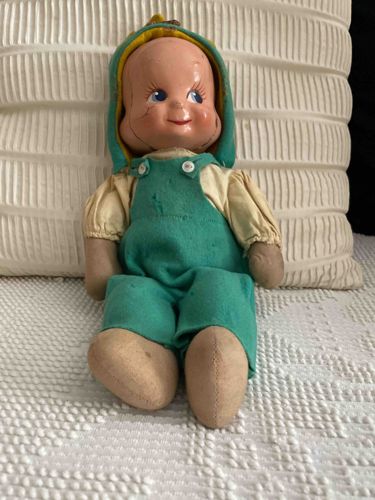
Vintage Three-Face Rotating Head Doll
This is a vintage 'three-face' or 'flirty eye' doll, likely dating from the mid-20th century, possibly the 1930s-1950s. The doll measures approximately 12-15 inches in height (estimated based on its seated posture and typical doll sizes of the era). Its most distinctive feature is the unique wooden head with a rotating mechanism that allows for three different facial expressions: smiling, sleeping (eyes closed), and crying. The carved wooden head is painted with a rosy, natural skin tone, and features hand-painted details for the eyes (blue with prominent black lashes), eyebrows, and red lips. The 'smiling' expression is currently visible, showing open blue eyes and an upturned mouth. The 'sleeping' and 'crying' expressions are present but not visible in the primary image. A notable condition issue on the head is the presence of cracks in the wood, particularly in the areas between the different expressions, which is a common occurrence with age and environmental exposure for this type of construction. The body of the doll appears to be made of cloth, likely stuffed fabric, given its soft, slouchy appearance and visible seams. The limbs are also fabric, with simplified stitched 'hands' and 'feet' that are not articulated. The doll is dressed in a light yellow/cream-colored long-sleeved shirt with elasticated cuffs, visible under a teal or greenish-blue pair of overalls. The overalls feature two white buttons on the chest straps and appear to be made of a felt-like or thick cotton fabric. A matching hood in the same teal color, lined with yellow, is attached to the overalls. The overall construction suggests factory production rather than handmade, although specific maker's marks or signatures are not visible. The general condition indicates wear consistent with age and play, including fading of the fabric, slight soiling, and the aforementioned cracks on the head. The craftsmanship, particularly of the wooden head and its rotating mechanism, suggests a creative and somewhat intricate manufacturing process for dolls of this period.
AI-Generated Appraisal Disclaimer
Estimated Value
$150-250
Basic Information
Category
Doll
Appraised On
December 5, 2025
Estimated Value
$150-250
Additional Details Provided By Owner
User Provided Information
Vintage doll with wooded head which rotates for 3 expressions; smiling, sleeping, crying. Cracks in wood between expressions
Item Description
This is a vintage 'three-face' or 'flirty eye' doll, likely dating from the mid-20th century, possibly the 1930s-1950s. The doll measures approximately 12-15 inches in height (estimated based on its seated posture and typical doll sizes of the era). Its most distinctive feature is the unique wooden head with a rotating mechanism that allows for three different facial expressions: smiling, sleeping (eyes closed), and crying. The carved wooden head is painted with a rosy, natural skin tone, and features hand-painted details for the eyes (blue with prominent black lashes), eyebrows, and red lips. The 'smiling' expression is currently visible, showing open blue eyes and an upturned mouth. The 'sleeping' and 'crying' expressions are present but not visible in the primary image. A notable condition issue on the head is the presence of cracks in the wood, particularly in the areas between the different expressions, which is a common occurrence with age and environmental exposure for this type of construction. The body of the doll appears to be made of cloth, likely stuffed fabric, given its soft, slouchy appearance and visible seams. The limbs are also fabric, with simplified stitched 'hands' and 'feet' that are not articulated. The doll is dressed in a light yellow/cream-colored long-sleeved shirt with elasticated cuffs, visible under a teal or greenish-blue pair of overalls. The overalls feature two white buttons on the chest straps and appear to be made of a felt-like or thick cotton fabric. A matching hood in the same teal color, lined with yellow, is attached to the overalls. The overall construction suggests factory production rather than handmade, although specific maker's marks or signatures are not visible. The general condition indicates wear consistent with age and play, including fading of the fabric, slight soiling, and the aforementioned cracks on the head. The craftsmanship, particularly of the wooden head and its rotating mechanism, suggests a creative and somewhat intricate manufacturing process for dolls of this period.
Related Tags
Get Your Items Appraised
Instant estimates of your treasures with AI-powered instant appraisals